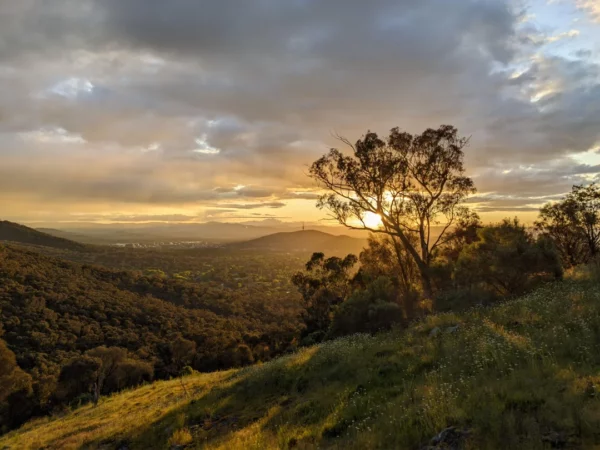I recently got home from work to find a very irritable teen lying on the couch on his device. I asked how his day was and he promptly bit my head off (how dare I take an interest in his day!). I suggested he go for a walk (I know, playing with fire), but he refused (surprise, surprise). So how did I get my teenager off screen?
I said I would confiscate his phone if he didn’t go outside.
He jumped up and flew out the front door.
An hour later he skipped happily back inside the house and thanked me. It was a wonder to behold.
Most of us don’t need science to tell us that grumpy, moody teens are happier when they get outside. But what’s causing these mood swings and how do we keep them swinging in the right direction?
Research shows we’re all healthier and happier when we spend time in nature, particularly if we’re moving about together. But 90% of Aussie teens are not getting the recommended 60 minutes of moderate physical activity per day, according to World Health Organisation funded research in The Lancet last week.
Lack of physical activity has been linked to all sorts of chronic diseases such as diabetes, obesity, heart disease, mental illness and languishing. There are now hundreds of studies and Systematic Reviews showing the link between health and moving in nature.
And as journalist Richard Louv highlights in “Last Child in the Woods”, Nature Deficit Disorder, or lack of nature experiences, can have serious health implications for teenagers.
While many of us have personally experienced how a walk along the beach or simply spending time outside shifts our mood, getting our teens to do it is not that easy, especially when you’re dragging them off screens.
But when you do, there’s all sorts of wonderful benefits to behold.
Being in nature usually involves moving which has been linked to improvements in teen depression and anxiety. Harvard Health studies demonstrate how physical activity counteracts depressive symptoms in both teens and adults.
Physical activity also lifts serotonin levels, which improves mental health, reduces stress and stimulates endorphins, which kill pain and elevate mood. In fact, studies show physical activity can be as effective as antidepressants in some cases.
Outdoor activities provide opportunities for teens to manage risk and push their physical, mental and emotional limits which develops resilience and self-confidence.
A 2015 study published in the International Journal of Environmental Research and Public Health showed that kids who explored nature and took part in “risky outdoor play” such as climbing and jumping, displayed improvements in social skills, resilience, and creativity.
Nature provides natural obstacle courses and once outside, teens are easily tempted by challenges such as scrambling around rocks, scaling high walls, navigating rivers, or finding a base camp in the bush.
Here are my tips for getting teenagers outside and loving nature.
1. Encourage them to bring friends.
Most teens love hanging out with their friends and social connection is one of the key pillars of wellbeing. Invite your teen’s friends along for a sunset or moonlight hike, a swim at the local billabong, a jump off a waterfall, a picnic by the lake or a tree climbing expedition.
2. Give them a couple of options and let them choose.
Involving your teen in the planning and preparation for an outdoor adventure is half the fun. Ask them what their favourite kinds of wild locations are and guide them to choose a suitable one to go exploring. There’s lots of fabulous adventures to be discovered in your local area and a Google search will lead you to heaps of fun options.
This will get them excited about the adventure in the lead up and they’ll feel more empowered and committed. You might suggest walking to a park, forest, waterfall, river, lake, cliff top or billabong but let them plan what happens when you’re there. You might even do a little reckie with them ahead of time and then return at a later date with their friends. That way you get twice the value out of the one location.
3. Do something adventurous.
If the backyard, local park or bush reserve isn’t enough to excite your teen, go farther afield on the weekend. Entice them with an exciting challenge such as climbing a hill or a little mountain, cross-country skiing, rock hopping or canyoning along a river or gorge, or sign them up for a ropes course. Depending on their age and experience, you will soon be able to slip into the background and leave them to explore, or even drop them off and pick them up later.
4. Create or send them on a wilderness adventure.
If you want your teen to love nature adventures, plan an adventure challenge like a weekend hike, rogaining, Geocaching, a treasure hunt or a micro-adventure with them. You might decide you’ll all go exploring along the coast or find a multi beach challenge or a National park wildlife discovery challenge. You might still need to include one or two of their friends to entice them, but it will be worth it if they fall in love with natures adventures.
As they get older, you’ll soon be able to encourage them to organise their own adventure with their friends and even look into catching public transport to their destination.
5. Support your teen to be a nature mentor to younger children.
Teens are often drawn toward sharing and teaching what they know and enjoy. Consider ways to help them in find opportunities to share the benefits of nature with younger children. For example, they might want to take a younger sibling for a weekly nature walk, volunteer for an outdoor organization, become a volunteer conservationist or work as a camp counsellor. That way, your teen gets outside more, and they’re also making a positive difference for other young people which is another key pillar of wellbeing.
6. Survival Skills
Most teens like the idea being a “Bear Grylls” in the wild. This means they need some survival skills, so if you don’t have these skills yourself, book them into Scouts, Cubs, Venturers or a Wilderness Survival Course and let them teach you. Or go along as a family. It might be the best birthday present money can buy.
7. Go camping, walking or biking in a National Park
Most teens love exploring in nature so try camping. If your teen is reluctant, let them bring a friend along. Discuss the risks, make sure they have a backpack with water, raincoat and a whistle, and leave them to explore. Teach them how to set up a tent, use the stove, roast marshmallows and go exploring in the bush after dark.
8. Prepare for reluctance
It can be hard to encourage your teens to get outside, especially if they’re addicted to their screens. Unless you managed to get them hooked when they were little, they’re not usually excited about hiking up a challenging hill, going camping or climbing. But push through. Make a deal with them – for example: for every two hours you spend on your phone you need to spend one hour outside. Once they get there (and get over their mood), they’ll end up having a great time and you can help them reflect on how much fun they had.
We all need to get outside more for our health and wellbeing, so exploring natures adventures with your teen is a win for everybody’s physical and mental health.









